Aprilia PEGASO 650 User Manual 2000
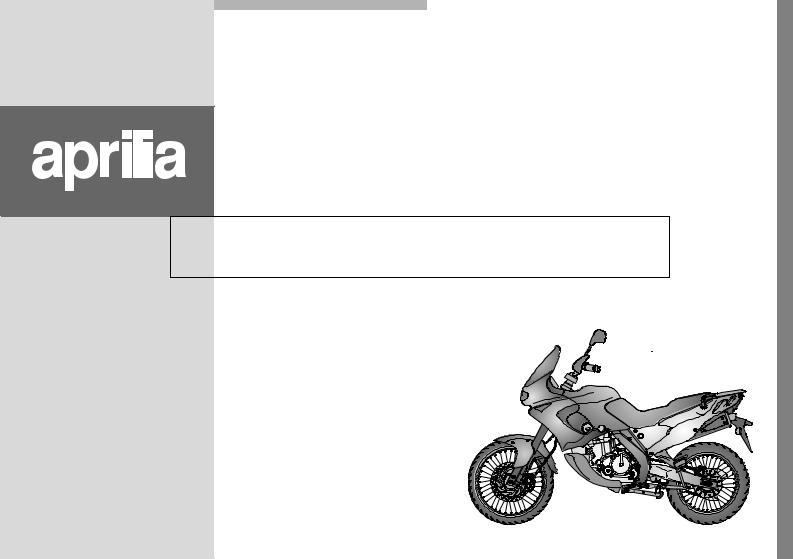
use and maintenance
Pegaso 650

© 1996 aprilia s.p.a. - Noale (VE)
First edition: december 1996
Reprint: january 2000
Produced and printed by:
editing division
Soave (VERONA) - Italy
Tel. +39 - 045 76 11 911
Fax +39 - 045 76 12 241
E-mail: customer@stp.it
www.stp.it
On behalf of: aprilia s.p.a.
via G. Galilei, 1 - 30033 Noale (VE) - Italy Tel. +39 - 041 58 29 111
Fax +39 - 041 44 10 54 www.aprilia.com
3!&%49 7!2.).'3
The following precautionary warnings are used throughout this manual in order to convey the following messages:
Safety warning. When you find this asymbol on the vehicle or in the manual, be careful to the potential risk of personal injury. Non-compliance with the indications given in the messages preceded by this symbol may result in grave risks for your and other people’s safety and for the vehicle!
cIndications to make the operations easier. Technical informa-
tion.
4%#(.)#!,
The operations preceded by this symbol must be repeated also on
the opposite side of the vehicle.
If not expressly indicated otherwise, for the reassembly of the units repeat the disassembly operations in reverse order.
The terms “right” and “left” are referred to the rider seated on the vehicle in the normal riding position.
7!2.).'3 02%#!54)/.3 '%.%2!, !$6)#%
Before starting the engine, carefully read this manual and in particular the section “SAFE DRIVE”.
Your and other people’s safety depends not only on your quickness of reflexes and on your agility, but also on what you know about the vehicle, on its efficiency and on your knowledge of the basic information for “SAFE DRIVE”. Therefore, get a thorough knowledge of the vehicle, in such a way as to be able to drive in the traffic safely.
2 use and maintenance Pegaso 650

cThis manual must be considered as an integral part of the vehicle and must always accompany it, even in
case of resale.
aprilia has carried out this manual with the maximum attention, in order to supply the user with correct and updated information. However, since aprilia constantly improves the design of its products, there may be slight discrepancies between the characteristics of your vehicle and those described in this manual. For any clarification concerning the information contained in this manual, do not hesitate to contact your aprilia Official Dealer.
For control and repair operations not expressly described in this publication, for the purchase of aprilia genuine spare parts, accessories and other products, as well as for specific advice, contact exclusively aprilia Official Dealers and Service Centers, which guarantee prompt and accurate assistance.
Thank you for choosing aprilia. We wish you a nice ride.
All rights as to electronic storage, reproduction and total or partial adaptation, with any means, are reserved for all Countries.
cIn some countries the antipollution and noise regulations in force re-
quire periodical inspections.
The user of the vehicle in these countries must:
–contact an aprilia Authorized Dealer to have the non-homologated components replaced with others homologated for use in the country in question;
–carry out the required periodical inspections.
cWhen asking your Dealer for spare parts, specify the spare parts code indicated on the SPARE PARTS IDENTIFI-
CATION LABEL.
Write down the identification code in the space here below, in order to remember it also in case of loss or deterioration of the label.
The label is positioned under the rider saddle, stuck to the frame.
In this manual the various versions are indicated by the following symbols:
&optional
2catalytic version
VERSION: |
|
I Italy |
V Poland |
U United Kingdom % Israel |
|
A Austria |
K South Korea |
P Portugal |
M Malaysia |
" Finland |
R Chile |
B Belgium |
QBermuda |
D Germany |
-United States |
|
of America |
F France |
^Australia |
E Spain |
]Brazil |
G Greece |
°South Africa |
O Holland |
ÎNew Zealand |
C Switzerland |
[Canada |
ˆ Denmark |
`Croatia |
J Japan |
ÑSlovenia |
S Singapore |
|
use and maintenance Pegaso 650 3

4!",% /& #/.4%.43 |
|
SAFE DRIVE ..................................................................................................... |
5 |
BASIC SAFETY RULES: ............................................................................ |
6 |
CLOTHING ................................................................................................. |
9 |
ACCESSORIES........................................................................................ |
10 |
LOAD ........................................................................................................ |
10 |
ARRANGEMENT OF THE MAIN ELEMENTS ............................................... |
12 |
ARRANGEMENT OF THE INSTRUMENTS ................................................... |
14 |
INSTRUMENTS AND INDICATORS .............................................................. |
14 |
INSTRUMENTS AND INDICATORS TABLE............................................ |
15 |
MAIN INDEPENDENT CONTROLS ............................................................... |
16 |
CONTROLS ON THE LEFT SIDE OF THE HANDLEBAR....................... |
16 |
CONTROLS ON THE RIGHT SIDE OF THE HANDLEBAR .................... |
17 |
IGNITION SWITCH................................................................................... |
18 |
STEERING LOCK..................................................................................... |
18 |
AUXILIARY EQUIPMENT............................................................................... |
19 |
UNLOCKING/LOCKING THE SADDLE.................................................... |
19 |
GLOVE/TOOL KIT COMPARTMENT....................................................... |
19 |
CRASH HELMET HOOK .......................................................................... |
20 |
ANTI-THEFT HOOK ................................................................................. |
20 |
REAR LUGGAGE RACK .......................................................................... |
20 |
MAIN COMPONENTS..................................................................................... |
21 |
FUEL......................................................................................................... |
21 |
ENGINE OIL ............................................................................................. |
21 |
BRAKE FLUID (recommendations) .......................................................... |
22 |
DISC BRAKES.......................................................................................... |
22 |
FRONT BRAKE ........................................................................................ |
23 |
REAR BRAKE........................................................................................... |
24 |
ADJUSTING THE REAR BRAKE ............................................................. |
24 |
CLUTCH ................................................................................................... |
25 |
COOLANT ................................................................................................ |
26 |
TYRES...................................................................................................... |
27 |
EXHAUST SILENCERS ^.................................................................... |
28 |
CATALYTIC SILENCERS 2................................................................. |
28 |
INSTRUCTIONS FOR USE............................................................................. |
29 |
PRELIMINARY CHECKING OPERATIONS............................................. |
29 |
STARTING................................................................................................ |
30 |
DEPARTURE AND DRIVE ....................................................................... |
32 |
RUNNING-IN ............................................................................................ |
34 |
STOPPING ............................................................................................... |
34 |
PARKING.................................................................................................. |
34 |
SUGGESTIONS TO PREVENT THEFT................................................... |
35 |
MAINTENANCE .............................................................................................. |
36 |
REGULAR SERVICE INTERVALS CHART ............................................. |
36 |
IDENTIFICATION DATA........................................................................... |
37 |
AIR CLEANER.......................................................................................... |
38 |
CHECKING THE ENGINE OIL LEVEL AND TOPPING UP .................... |
39 |
CHANGING THE ENGINE OIL AND THE OIL FILTER ........................... |
40 |
FRONT WHEEL....................................................................................... |
42 |
REAR WHEEL ......................................................................................... |
44 |
CHAIN...................................................................................................... |
46 |
REMOVING THE FUEL TANK................................................................. |
48 |
REMOVING |
|
THE RIGHT AND LEFT SIDES................................................................ |
48 |
CHECKING THE STEERING................................................................... |
49 |
CHECKING |
|
THE REAR FORK FULCRUM AXIS ........................................................ |
49 |
INSPECTING THE FRONT AND REAR SUSPENSIONS ....................... |
49 |
REAR SUSPENSION............................................................................... |
50 |
REAR SUSPENSION |
|
WITH HYDRAULIC PRELOAD ADJUSTMENT &............................... |
50 |
IDLING ADJUSTMENT............................................................................ |
52 |
ADJUSTING THE ACCELERATOR CONTROL ...................................... |
52 |
ADJUSTING THE COLD START CONTROL (e)................................... |
52 |
SPARK PLUG .......................................................................................... |
53 |
BATTERY................................................................................................. |
54 |
CHECKING THE ELECTROLYTE LEVEL.............................................. |
55 |
RECHARGING THE BATTERY............................................................... |
55 |
LONG INACTIVITY OF THE BATTERY ................................................. |
55 |
CHANGING THE FUSES......................................................................... |
56 |
CHECKING THE SIDE STAND AND THE SAFETY SWITCH ................ |
57 |
ADJUSTING |
|
THE HEADLIGHT BEAM ......................................................................... |
58 |
BULBS ..................................................................................................... |
58 |
CHANGING THE HEADLIGHT BULBS ................................................... |
59 |
CHANGING THE REAR LIGHT BULB.................................................... |
60 |
CHANGING THE FRONT DIRECTION INDICATOR BULBS.................. |
60 |
CHANGING THE REAR DIRECTION INDICATOR BULBS .................... |
61 |
CHANGING |
|
THE NUMBER PLATE BULB................................................................... |
61 |
TRANSPORT.................................................................................................. |
62 |
DRAINING THE FUEL TANK................................................................... |
62 |
CLEANING ..................................................................................................... |
63 |
LONG PERIODS OF INACTIVITY........................................................... |
64 |
TECHNICAL DATA ........................................................................................ |
65 |
LUBRICANT TABLE ................................................................................ |
68 |
Importers............................................................................................. |
70-71 |
WIRING DIAGRAM - Pegaso 650............................................................ |
72 |
WIRING DIAGRAM KEY - Pegaso 650 ................................................... |
73 |
4 use and maintenance Pegaso 650
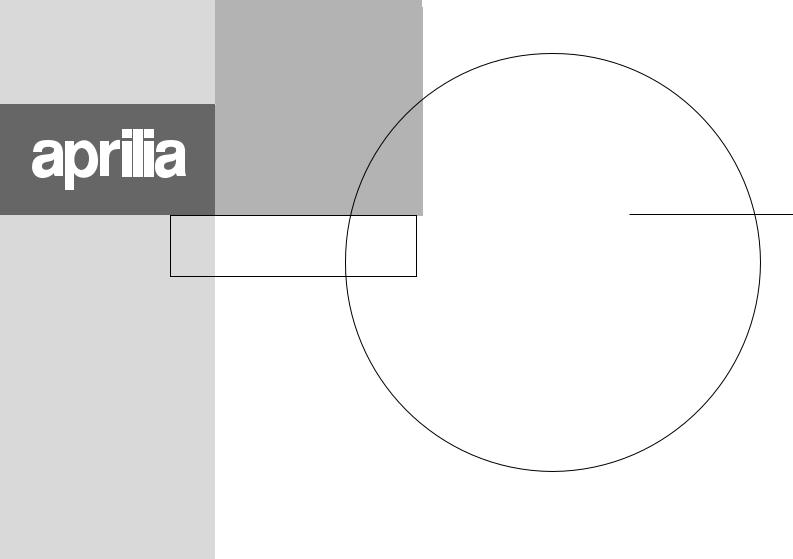
safe drive
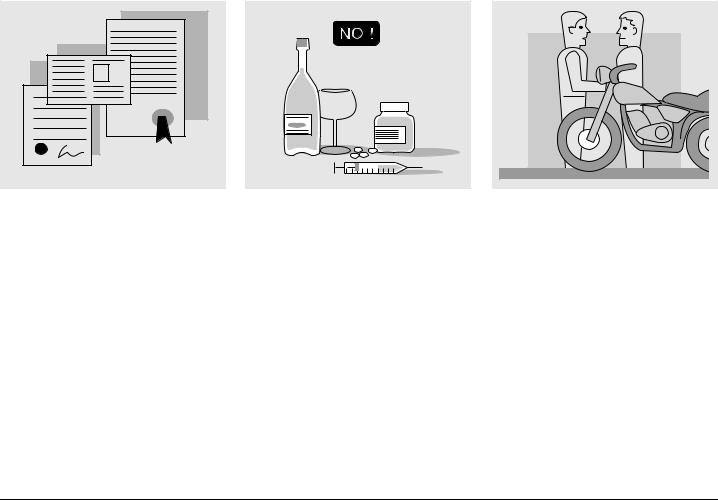
"!3)# 3!&%49 25,%3 |
To drive the vehicle it is necessary to be in possession of all the requirements prescribed by law (driving licence, minimum age, psychophysical ability, insurance, state taxes, vehicle registration, number plate, etc.).
Gradually get to know the vehicle by driving it first in areas with low traffic and/or private areas.
The use of medicins, alcohol and drugs or psychotropic substances notably increases the risk of accidents.
Be sure that you are in good psychophysical conditions and fit for driving and pay particular attention to physical weariness and drowsiness.
Most road accidents are caused by the driver’s lack of experience.
NEVER lend the vehicle to beginners and, in any case, make sure that the driver has all the requirements for driving.
6 use and maintenance Pegaso 650

Rigorously observe all road signs and national and local road regulations.
Avoid abrupt movements that can be dangerous for yourself and other people (for example: rearing up on the back wheel, speeding, etc.), and give due consideration to the road surface, visibility and other driving conditions.
Avoid obstacles that could damage the vehicle or make you lose control.
Avoid riding in the slipstream created by preceding vehicles in order to increase your speed.
Always drive with both hands on the handlebars and both feet on the footrests (or on the rider’s footboards), in the correct driving posture.
Avoid standing up or stretching your limbs while driving.
use and maintenance Pegaso 650 7
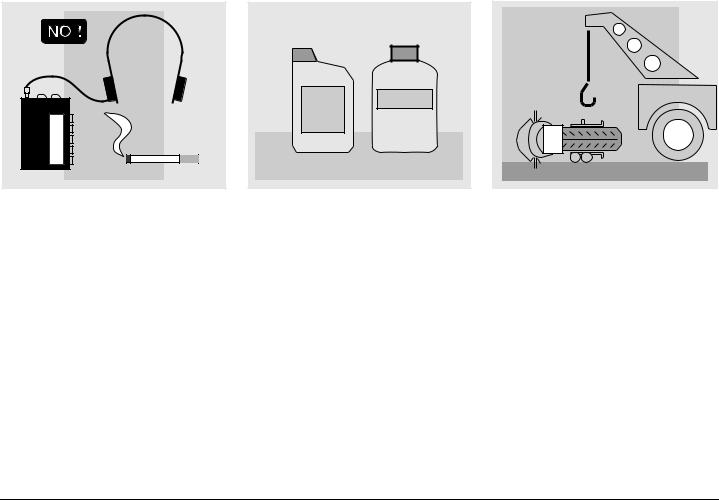
The driver should pay attention and avoid distractions caused by people, things and movements (never smoke, eat, drink, read, etc.) while driving.
COOLER |
OIL |
Use only the vehicle’s specific fuels and lubricants indicated in the "LUBRICANT CHART"; check the oil, fuel and coolant levels regularly.
If the vehicle has been involved in an accident, make sure that no damage has occurred to the control levers, pipes, wires, braking system and vital parts.
If necessary, have the vehicle inspected by an aprilia Official Dealer, who should carefully check the frame, handlebars, suspensions, safety parts and all the devices that you cannot check by yourself.
Always remember to report any malfunction to the technicians to help them in their work.
Never use the vehicle when the amount of damage it has suffered endangers your safety.
8 use and maintenance Pegaso 650
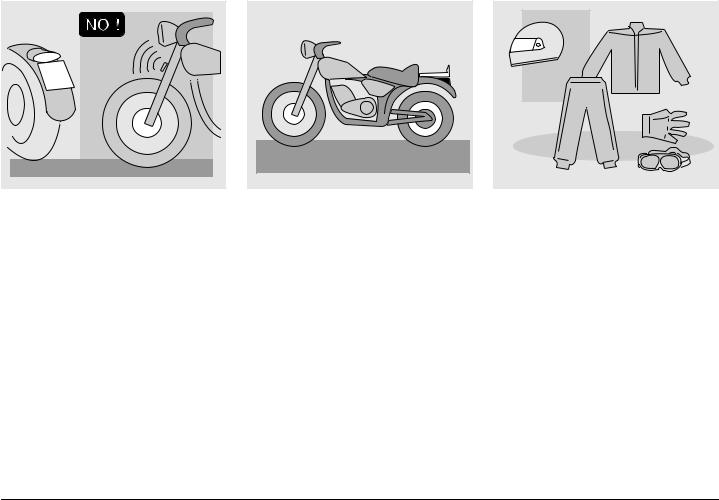
A12 |
345 |
Never change the position, inclination or colour of: number plate, direction indicators, lights and horns.
Any modification of the vehicle will result in the invalidity of the guarantee.
ONLY ORIGINALS
Any modification of the vehicle and/or the removal of original components can compromise vehicle performance levels and safety or even make it illegal.
We recommend respecting all regulations and national and local provisions regarding the equipment of the vehicle.
In particular, avoid all modifications that increase the vehicle’s performance levels or alter its original characteristics.
Never race with other vehicles.
#,/4().' |
Before starting, always wear a correctly fastened crash helmet. Make sure that it is homologated, in good shape, of the right size and that the visor is clean.
Wear protective clothing, preferably in light and/or reflecting colours. In this way you will make yourself more visible to the other drivers, thus notably reducing the risk of being knocked down, and you will be more protected in case of fall.
This clothing should be very tight-fitting and fastened at the wrists and ankles. Strings, belts and ties should not be hanging loose; prevent these and other objects from interfering with driving by getting entangled with moving parts or driving mechanisms.
use and maintenance Pegaso 650 9
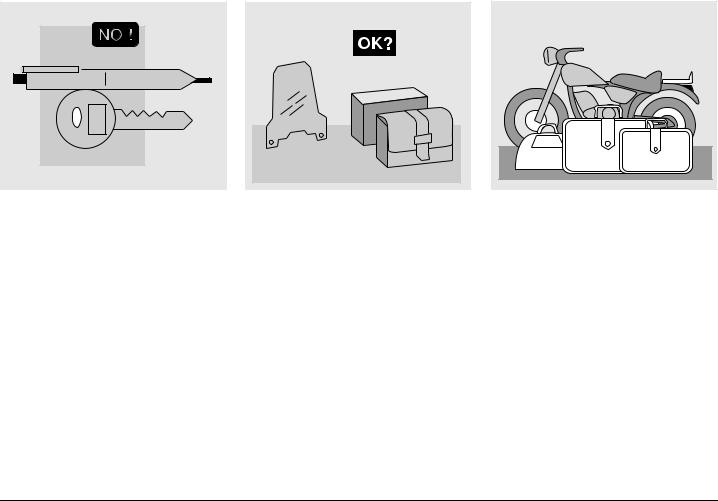
Do not keep objects that can be dangerous in case of fall, for example pointed objects like keys, pens, glass vials etc. in your pockets (the same recommendations also apply to passengers).
!##%33/2)%3
The owner of the vehicle is responsible for the choice, installation and use of any accessory.
Avoid installing accessories that cover horns or lights or that could impair their functions, limit the suspension stroke and the steering angle, hamper the operation of the controls and reduce the distance from the ground and the angle of inclination in turns.
Avoid using accessories that hamper access to the controls, since this can prolong reaction times during an emergency.
Large fairings and windscreens assembled on the vehicle can produce aerodynamic forces capable of compromising the stability of the vehicle while driving.
Make sure that the equipment is well fastened to the vehicle and not dangerous during driving. Do not install electrical devices and do not modify those already existing to avoid electrical overloads, because the vehicle could suddenly stop or there could be a dangerous current shortage in the horn and in the lights. aprilia recommends the use of genuine accessories (aprilia genuine accessories).
,/!$
Be careful and moderate when loading your luggage. Keep any luggage loaded as close as possible to the centre of the vehicle and distribute the load uniformly on both sides, in order to reduce imbalance to the minimum. Furthermore, make sure that the load is firmly secured to the vehicle, especially during long trips.
10 use and maintenance Pegaso 650
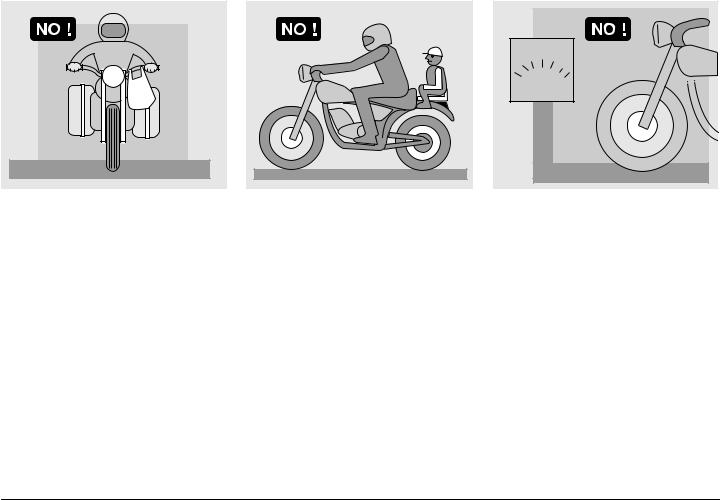
KG! |
Avoid hanging bulky, heavy and/or dangerous objects on the handlebars, mudguards and forks, because the vehicle might respond more slowly in turns and its manoeuvrability could be unavoidably impaired.
Do not place bags that are too bulky on the vehicle sides and do not ride with the crash helmet hanging from its string, because it could hit people or obstacles making you lose control of the vehicle.
Do not carry any bag if it is not tightly secured to the vehicle.
Do not carry bags which protrude too much from the luggage rack or which cover the lights, horn or indicators.
Do not carry animals or children on the glove compartment or on the luggage rack.
Do not exceed the maximum load allowed for each side-bag.
When the vehicle is overloaded, its stability and its manoeuvrability can be compromised.
use and maintenance Pegaso 650 11
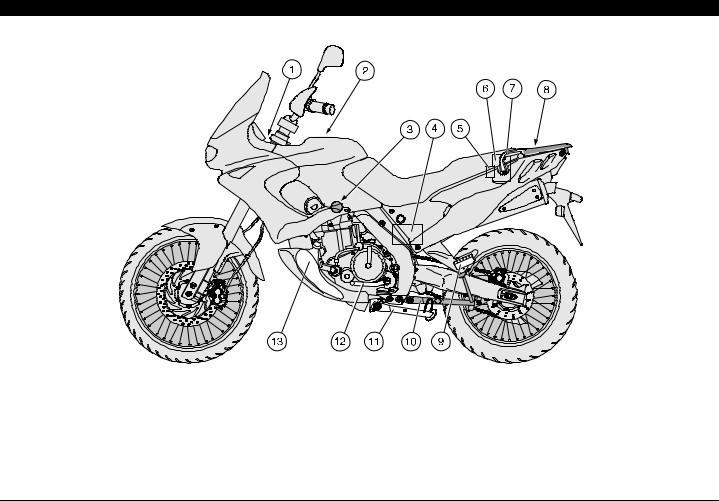
!22!.'%-%.4 /& 4(% -!). %,%-%.43
|
|
|
|
|
|
|
|
|
|
|
|
|
|
|
|
|
|
|
|
|
|
|
|
|
|
|
|
|
|
|
|
|
|
|
|
|
|
|
|
|
|
|
|
|
|
|
|
|
|
|
|
|
|
|
|
|
|
|
|
|
|
|
|
|
|
|
|
|
|
+%9 |
|
|
|
|
|
|
|
||
1) |
Ignition switch/steering lock |
8) |
Rear luggage rack |
||||||
2) |
Fuel tank plug |
9) |
Passenger footrest |
||||||
3) |
Fuel cock |
10) |
Central stand & |
||||||
4) |
Battery |
11) |
Side stand |
||||||
5) |
Fuses |
12) |
Shifting lever |
||||||
6) |
Glove/tool kit compartment |
13) |
Expansion tank |
||||||
7) |
Passenger grab rail |
|
|
|
|
|
|
|
|
12 use and maintenance Pegaso 650
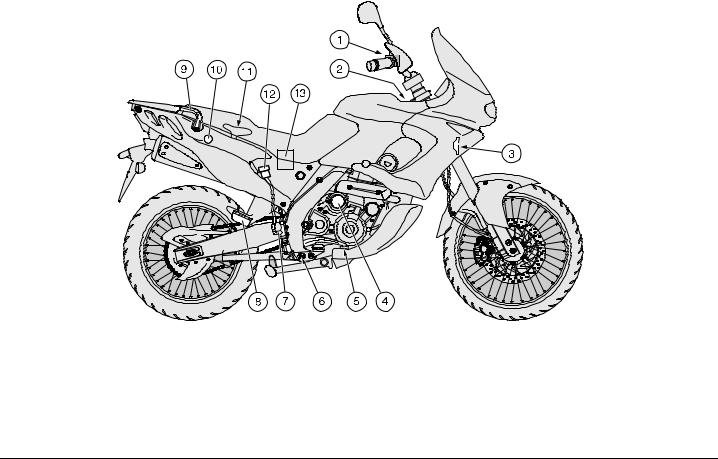
|
|
|
|
|
|
|
|
|
|
|
|
|
|
|
|
|
|
|
|
|
|
|
|
|
|
|
|
|
|
|
|
|
|
|
|
|
|
|
|
|
|
|
|
|
|
|
|
|
|
|
|
|
|
|
|
|
|
|
|
|
|
|
|
|
|
+%9 |
|
|
|
|
|
|
|
|
||
1) |
Front brake master cylinder |
7) |
Rear brake master cylinder |
|
||||||
2) |
Engine oil level plug-dipstick |
8) |
Passenger footrest |
|
||||||
3) |
Horn |
9) |
Passenger grab rail |
|
||||||
4) |
Engine oil filter |
10) |
Saddle lock |
|
||||||
5) |
Rear brake control lever |
11) |
Crash helmet hook |
|
||||||
6) |
Anti-theft hook (for the aprilia “Body- |
12) |
Rear brake fluid tank |
|
||||||
|
|
Guard” armored cable &) |
13) |
Air cleaner |
|
|||||
use and maintenance Pegaso 650 13
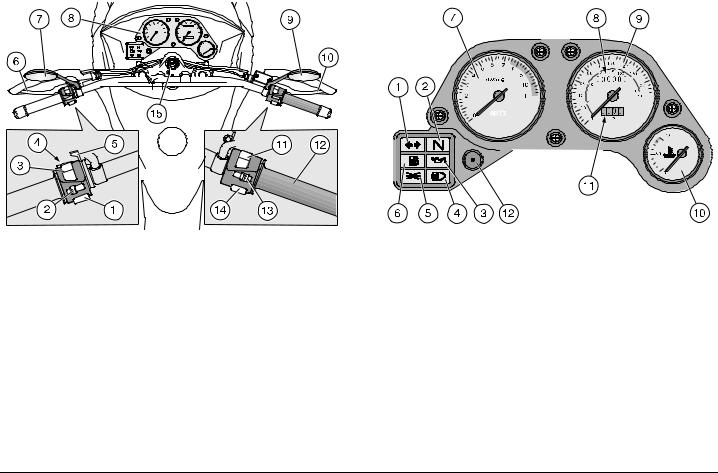
|
!22!.'%-%.4 /& 4(% ).3425-%.43 |
|
).3425-%.43 !.$ ).$)#!4/23 |
|
|||||||||||||||||||||||||
|
|
|
|
|
|
|
|
|
|
|
|
|
|
|
|
|
|
|
|
|
|
|
|
|
|
|
|
|
|
|
|
|
|
|
|
|
|
|
|
|
|
|
|
|
|
|
|
|
|
|
|
|
|
|
|
|
|
|
|
|
|
|
|
|
|
|
|
|
|
|
|
|
|
|
|
|
|
|
|
|
|
|
|
|
|
|
|
|
|
|
|
|
|
|
|
|
|
|
|
|
|
|
|
|
|
|
|
|
|
|
|
|
|
|
|
|
|
|
|
|
|
|
|
|
|
|
|
|
|
|
|
|
|
|
|
|
|
|
|
|
|
|
|
|
|
|
|
|
|
|
|
|
|
|
|
|
|
|
|
|
|
|
|
|
|
|
|
|
|
|
|
|
|
|
|
|
|
|
|
|
|
|
|
|
|
|
|
|
|
|
|
|
|
|
|
|
|
|
|
|
|
|
|
|
|
|
|
|
|
|
|
|
|
|
|
|
|
|
|
|
|
|
|
|
|
|
|
|
|
|
|
|
|
|
|
|
|
|
|
|
|
|
|
|
|
|
|
|
|
|
|
|
|
|
|
|
|
|
|
|
|
|
|
|
|
|
|
|
|
|
|
|
|
|
|
|
|
|
|
|
|
|
|
|
|
|
|
|
|
|
|
|
|
|
|
|
|
|
|
|
|
|
|
|
|
|
|
|
|
|
|
|
|
|
|
|
|
|
|
|
|
|
|
|
|
|
|
|
|
|
|
|
|
|
|
|
|
|
|
|
|
|
|
|
|
|
|
|
|
|
|
|
|
|
|
|
|
|
|
|
|
|
|
|
|
|
|
|
|
|
|
|
|
|
|
|
|
|
|
|
|
|
|
|
|
|
|
|
|
|
|
|
|
|
|
|
|
|
|
|
|
|
|
|
|
|
|
|
|
|
|
|
|
|
|
|
|
|
|
|
|
|
|
|
|
|
|
|
|
|
|
|
|
|
|
|
|
|
|
|
|
|
|
|
|
|
|
|
|
|
|
|
|
|
|
|
|
|
|
|
|
|
|
|
|
|
|
|
|
|
|
|
|
|
|
|
|
|
|
+%9 |
+%9 |
||
1) |
Horn push button (f) |
1) |
Green direction indicator warning light (c) |
2) |
Direction indicator switch (c) |
2) |
Green neutral indicator warning light (q) |
3) |
Dimmer switch (b - a) |
3) |
Red engine oil pressure warning light (j) |
4) |
High beam signalling push button (a) |
4) |
Blue high beam warning light (a) |
5) |
Cold start lever (e) |
5) |
Green low beam and parking light warning light (p) |
6) |
Clutch lever |
6) |
Amber low fuel warning light (g) |
7) |
Left rear-view mirror |
7) |
Revolution counter |
8) |
Instruments and indicators |
8) |
Total kilometres odometer |
9) |
Right rear-view mirror |
9) |
Speedometer |
10) Front brake lever |
9) |
Speedometer - only km/h scale ^ |
|
11) Engine stop switch (n - m) |
10) Coolant temperature indicator (h) |
||
12) |
Throttle grip |
11) Partial kilometres odometer |
|
13) |
Light switch (o - p - •) |
12) |
Odometer trip control |
14)Start push button (r)
15)Ignition switch/steering lock (n - m - s)
14 use and maintenance Pegaso 650
).3425-%.43 !.$ ).$)#!4/23 4!",%
Description |
|
Function |
|
|
|
Direction indicator |
|
It blinks when the direction indicators are on. |
warning light |
c |
|
|
|
|
Neutral indicator warning light |
q |
It comes on when the gear is in neutral. |
|
|
It comes on every time the ignition switch is brought to position "n" and the engine is not run- |
|
|
ning, thus checking the proper functioning of the lamp. If during this phase the lamp does not |
Engine oil pressure |
|
turn on, it must be replaced. The warning light must go off when the engine is running. |
|
|
|
warning light |
j |
If the warning light comes on during the normal running of the engine, this |
|
|
|
|
|
means that the oil pressure in the circuit is insufficient. In this case, immediate- |
|
|
aly stop the engine and contact your APRILIA Official Dealer. |
High beam warning light |
a |
It comes on when the headlight is in "high beam" position or when the high beam signalling is |
|
|
operated. |
Parking light |
|
It comes on when the lights are on. |
and low beam warning light |
p |
|
Low fuel warning light |
g |
It comes on when the quantity of fuel left in the tank is about 6 L (electrical reserve). |
|
|
In this case, provide for immediate topping up, see p. 21 (FUEL). |
|
|
It indicates the number of revolutions of the engine per minute. |
Revolution counter |
|
aNever exceed the engine max. rpm, see p. 34 (RUNNING-IN). |
|
|
|
Total kilometres odometer |
|
It indicates the total number of kilometres covered. |
Speedometer |
|
It indicates the driving speed. |
|
|
It indicates the approximate temperature of the coolant in the engine. When the pointer starts |
|
|
moving beyond level "40", the temperature is sufficient for driving the vehicle. The normal |
|
|
running temperature range is indicated by the graduated area of the scale. If the pointer |
Coolant temperature indicator |
h |
reaches the red area, stop the engine and check the coolant level, see p. 26 (COOLANT). |
|
|
If the maximum allowed temperature is exceeded (red area of the scale), the en- |
|
|
agine may be seriously damaged. |
Partial kilometres odometer |
|
It indicates the partial number of kilometres covered. To set it to zero, use the odometer trip control. |
Odometer trip control |
|
Rotate it anticlockwise to set the partial kilometres odometer to zero. |
|
|
|
use and maintenance Pegaso 650 15
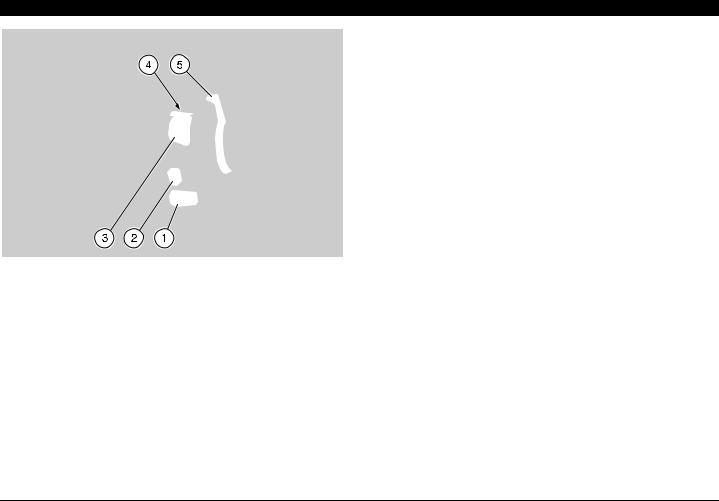
-!). ).$%0%.$%.4 #/.42/,3
#/.42/,3 /. 4(% ,%&4 3)$% /& 4(% (!.$,%"!2
cThe electrical parts work only when the ignition switch is in position "n".
1)HORN PUSH BUTTON (f)
The horn is activated when the push button is pressed.
2)DIRECTION INDICATOR SWITCH (c)
To indicate the turn to the left, move the switch to the left; to indicate the turn to the right, move the switch to the right. To turn off the direction indicator, press the switch on its centre.
3)DIMMER SWITCH (b - a)
When the light switch (right side of the handlebar) is in position "o", if the dimmer switch is in position "a", the high beam comes on, while if it is in position "b", the low beam comes on.
4)HIGH BEAM SIGNALLING PUSH BUTTON (a)
It makes it possible to use the high beam for signalling to forthcoming vehicles while overtaking and in case of peril and/or emergency.
5)COLD START LEVER (e)
The starter for the cold start of the engine is operated by rotating the lever "e" downwards.
To disconnect the starter, move the lever "e" to its initial position.
16 use and maintenance Pegaso 650
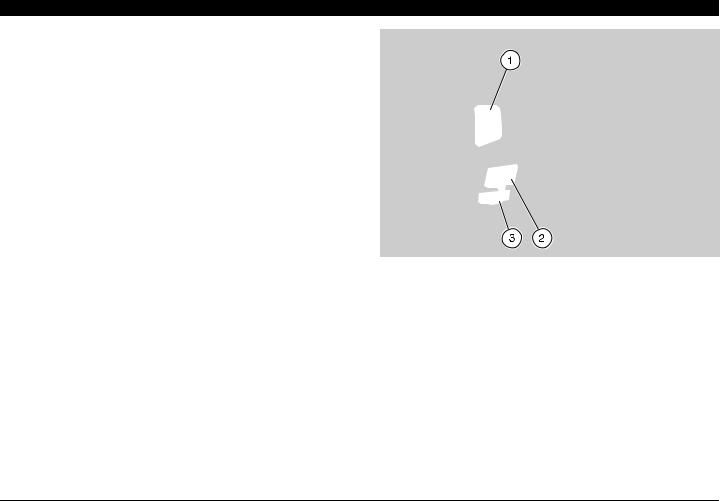
#/.42/,3 /. 4(% 2)'(4 3)$% /& 4(% (!.$,%"!2
cThe electrical parts work only when the ignition switch is in position "n".
1)ENGINE STOP SWITCH (n - m)
aDo not operate the engine stop switch “n - m” in running conditions.
This is a safety or emergency switch.
With the switch in position "n", it is possible to start the engine; the engine can be stopped by moving the switch to position "m".
With stopped engine and ignition switch in posi- ation "n", the battery may discharge.
When the vehicle has come to rest, after stopping the engine, move the ignition switch to position "m".
2)HEADLIGHT SWITCH (o - p - •)
When the light switch is in position "•", the lights are off; when the switch is in position "p", the parking lights are on; when the switch is in position "o", the low beam or the high beam is on.
The high/low beam can be operated by means of the dimmer switch, see p. 16 (CONTROLS ON THE LEFT SIDE OF THE HANDLEBAR).
3)START PUSH BUTTON (r)
When the start push button "r" is pressed, the starter makes the engine run. For the starting, see p. 30 (STARTING).
use and maintenance Pegaso 650 17
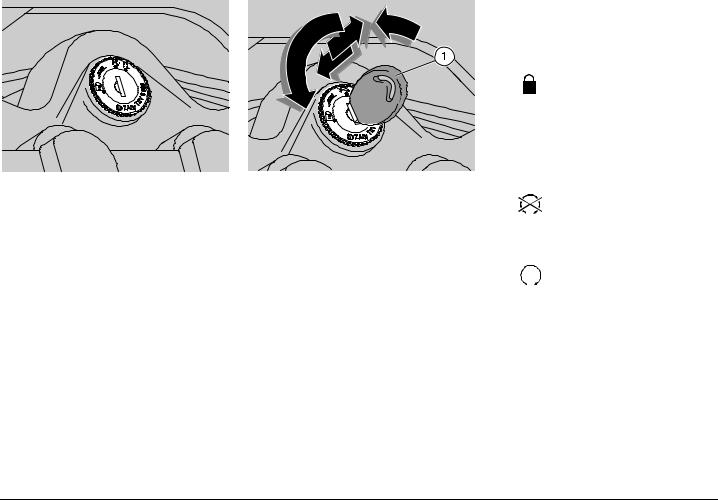
)'.)4)/. 37)4#(
The ignition switch is positioned on the steering column plate.
cThe key (1) operates the ignition switch/steering lock, the saddle
lock and the fuel tank lock.
Two keys are supplied together with the vehicle (one spare key).
34%%2).' ,/#+
Never turn the key to position "s" in running conditions, in order to avoid losing control of the vehicle.
OPERATION
To lock the steering:
Turn the handlebar completely leftwards.
Turn the key (1) to position “m” and press it.
Release the key.
cTurn the key and steer the handlebar at the same time.
Rotate the key (1) anticlockwise (leftwards), steer the handlebar slowly until the key (1) reaches position “s”.
Extract the key.
Position |
Function |
Key |
|
removal |
|||
|
|
||
|
|
|
|
|
The steer- |
It is possi- |
|
|
ing is |
ble to |
|
|
locked. |
remove the |
|
|
It is neither |
key. |
|
|
possible to |
|
|
Steering |
start the |
|
|
lock |
engine, nor |
|
|
|
to switch on |
|
|
|
the lights. |
|
|
|
|
|
|
|
Neither the |
It is possi- |
|
|
engine, nor |
ble to |
|
|
the lights |
remove the |
|
|
can be |
key. |
|
|
switched on. |
|
|
|
|
|
|
|
The engine |
It is not pos- |
|
|
and the |
sible to |
|
|
lights can be |
remove the |
|
|
switched on. |
key. |
|
|
|
|
18 use and maintenance Pegaso 650
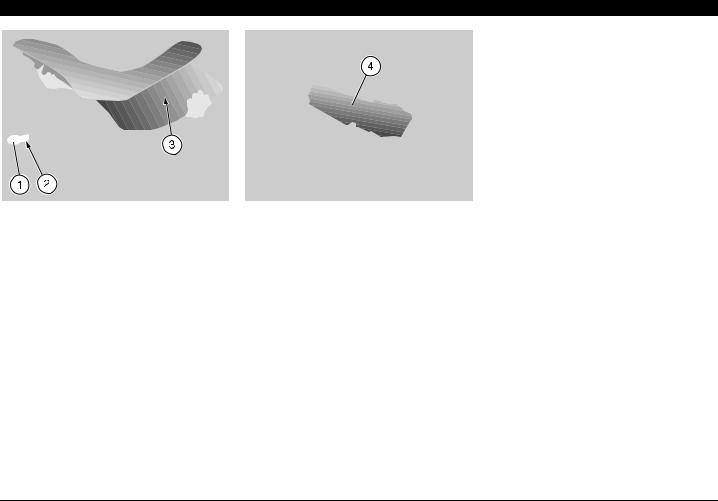
!58),)!29 %15)0-%.4
5.,/#+).' ,/#+).' 4(% 3!$$,%
Position the vehicle on the stand, see p. 35 (POSITIONING THE VEHICLE ON THE STAND).
Insert the key (1) in the saddle lock (2).
Turn the key (1) clockwise and raise and remove the saddle.
cBefore lowering and locking the saddle, make sure that you have not left the key in the glove/tool kit com-
partment.
To lock the saddle, position the tang (3) in its seat, then lower and press the saddle, thus making the lock snap shut.
aBefore leaving, make sure that the saddle is properly locked.
',/6% 4//, +)4 #/-0!24-%.4
The compartment is positioned under the rear part of the saddle;
to reach it:
Unlock and raise the saddle.
The tool kit (4) includes:
–3, 4, 5, 6, 8 mm Allen spanners
–5,5-7 mm double fork spanner
–8-11 mm double fork spanner
–10-13 mm double fork spanner
–19 mm simple fork spanner
–24 mm simple fork spanner
–double-ended, cross-/cut-headed screwdriver
–screwdriver handle
–18 mm spark plug socket spanner
–socket spanner rod
–tool case
Max. allowed weight: 1.5 kg
use and maintenance Pegaso 650 19
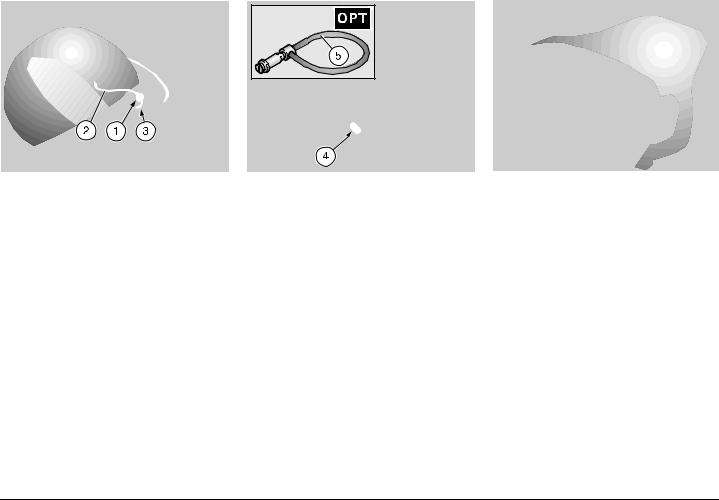
#2!3( (%,-%4 (//+
Thanks to the crash helmet hook, you no longer have to carry the crash helmet with you every time you park the vehicle.
Do not ride with the crash helmet ahanging from the hook, as this may seriously compromise your
safety.
To hang the crash helmet:
Raise the saddle.
Withdraw the eyelet (1) of the cable (2) from the hook (3).
Pass the cable (2) through the visor opening or through the apposite loop on the crash helmet.
Insert the eyelet (1) completely in the hook (3).
Lower the saddle and lock it.
!.4) 4(%&4 (//+
The anti-theft hook (4) is positioned on the right side of the vehicle, near the rider’s footboard.
To prevent the vehicle from being stolen, it is advisable to secure it with the aprilia “Body-Guard” armored cable &(5), available at any aprilia Official Dealer.
Do not use the hook to lift the ve- ahicle or for any purpose other than securing the vehicle once it
has been parked.
2%!2 ,5''!'% 2!#+
Max. allowed weight: 9 kg
20 use and maintenance Pegaso 650
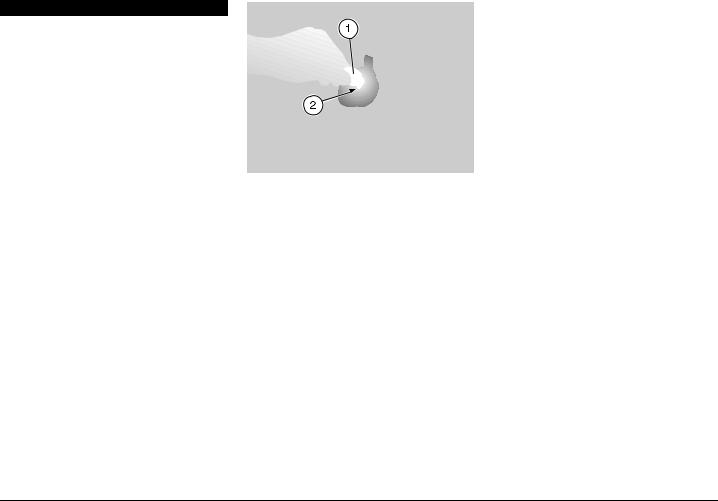
-!). #/-0/.%.43
&5%,
The fuel used for internal com- abustion engines is extremely inflammable and in particular conditions it can become explosive. It is important to carry out the refuelling and the maintenance operations in a wellventilated area, with the engine off. Do not smoke while refuelling or near fuel vapours, in any case avoid any contact with naked flames, sparks and any other heat source to prevent the fuel from catching fire or from exploding. Further, prevent fuel from flowing out of the fuel filler, as it could catch fire when getting in contact with the red-hot surfaces of
the engine.
In case some fuel has accidentally been spilt, make sure that the area has completely dried and before starting the vehicle verify that there is no fuel inside the fuel filler neck.
Since petrol expands under the heat of the sun and due to the effects of sun radiation, never fill the tank to the brim. Screw the plug up carefully after refuelling. Avoid any contact of the fuel with the skin and the inhalation of vapours; do not swallow fuel or pour it from a receptacle into another by means of a tube.
KEEP AWAY FROM CHILDREN
Use only premium grade petrol (4 Stars U), in conformity with the DIN 51600 standard, min. O.N. 98 (N.O.R.M.) and 88 (N.O.M.M.).
2 ^: Use only unleaded petrol, in conformity with the DIN 51607 standard, min. O.N. 95 (N.O.R.M.) and 85 (N.O.M.M.).
FUEL TANK CAPACITY (reserve included): 22 L
TANK RESERVE:
5 L (mechanical reserve).
To refuel, proceed as follows:
Insert the key (1) in the tank plug lock(2).
Turn the key clockwise, pull and open the fuel flap.
%.').% /),
cRemember:1 miles = 1.6 km
1 km = 0.625 miles
Check the engine oil level every 500 km, see p. 39 (CHECKING THE ENGINE OIL LEVEL AND TOPPING UP).
It is necessary to change the engine oil after the first 1000 km and successively every 6000 km, see p. 40 (CHANGING THE ENGINE OIL AND THE OIL FILTER).
cUse high-quality 5W-40 oil, see p. 68 (LUBRICANT TABLE).
Engine oil can cause serious adamage to the skin if handled
every day and for long periods. Wash your hands carefully after using the oil.
Do not dispose of the oil in the environment.
Put it in a sealed container and take it to the filling station where you usually buy it or to an oil salvage center.
use and maintenance Pegaso 650 21

"2!+% &,5)$ RECOMMENDATIONS
cThis vehicle is provided with front and rear disc brakes, with
separate hydraulic circuits.
The following information refers to a single braking system, but is valid for both.
Sudden resistance or clearance aproblems on the brake lever may be due to troubles in the hydrau-
lic system.
For any doubt regarding the perfect functioning of the braking system and in case you are not able to carry out the
usual checking operations, contact your APRILIA Official Dealer.
Make sure that the brake disc is aneither oily nor greasy, especially after maintenance or checking
operations.
Check that the brake cable is neither twisted nor worn out.
Prevent water or dust from accidentally getting into the circuit.
In case maintenance operations are to be performed on the hydraulic circuit, it is advisable to use latex gloves.
If the brake fluid gets in contact with the skin or the eyes, it can cause serious irritations.
Carefully wash the parts of your body that get in contact with the liquid. Consult a doctor or an oculist if the liquid gets in contact with your eyes.
Do not dispose of the brake fluid in the environment.
KEEP AWAY FROM CHILDREN
When using the brake fluid, take acare not to spill it on the plastic or painted parts, since it can
damage them.
$)3# "2!+%3
The brakes are the parts that amost ensure your safety and for this reason they must always be
perfectly working.
The brake fluid must be changed once a year by an APRILIA Official Dealer.
This vehicle is provided with front and rear hydraulic disc brakes.
When the disc pads wear out, the level of the fluid decreases to automatically compensate for their wear.
The front brake fluid tank is positioned on the handlebar, near the front brake lever coupling.
The rear brake fluid tank is positioned under the right side; to reach it, remove the right side, see p. 48 (REMOVING THE RIGHT AND LEFT SIDES).
Periodically check the brake fluid level in the tanks, see p. 23 (FRONT BRAKE) and the wear of the pads, see p. 51 (CHECKING THE BRAKE PAD WEAR).
22 use and maintenance Pegaso 650

&2/.4 "2!+%
Checking
cPositionflat ground.the vehicle on firm and
Keep the vehicle in vertical position and rotate the handlebar, so that the fluid contained in the tank is parallel to the brake fluid tank cover.
Make sure that the fluid level exceeds the "MIN" mark.
If the fluid does not reach the "MIN" mark, provide for topping up.
Topping up:
The brake fluid may flow out of athe tank. Do not operate the front brake lever if the screws (2) are loose or, most important, if the brake
fluid tank cover has been removed.
Unscrew the two screws (2) of the brake fluid tank (3).
Remove the cover (4).
cIn order not to spill the brake fluid while topping up, keep the fluid in the tank parallel to the tank rim (in
horizontal position).
Remove the gasket (5).
Fill the tank (3) with brake fluid, see p. 68 (LUBRICANT TABLE), until it covers the glass (1) completely.
To reassemble the components, follow the reverse order.
Check the braking efficiency. If anecessary, contact your APRILIA
Official Dealer.
In case of excessive stroke of the brake lever, of excessive elasticity or in case
there is air in the circuit, contact your APRILIA Official Dealer, since it may be
necessary to bleed the system.
In any case, the bleeding must be carried out after the first 1000 km.
cRemember:1 miles = 1.6 km
1 km = 0.625 miles
use and maintenance Pegaso 650 23
